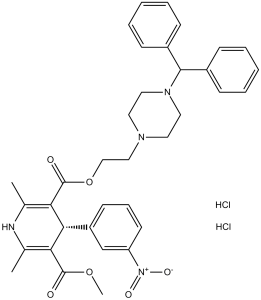Manidipine 2HCl (also called CV-4093; CV4093), the dihydrochloride salt form of Manidipine, is a calcium channel blocker/CCB that is used clinically as an antihypertensive agent. It inhibits the voltage-dependent calcium inward currents in smooth muscle cells, which results in systemic vasodilation. Comparing manidipine to other Ca2+ channel antagonists, it is said to exhibit minimal cardiodepression and selectively block T-type Ca2+ channels while having a high selectivity for the vasculature.
Physicochemical Properties
| Molecular Formula | C35H38N4O6.2HCL | |
| Molecular Weight | 683.62 | |
| Exact Mass | 682.2324904 | |
| Elemental Analysis | C, 61.49; H, 5.90; Cl, 10.37; N, 8.20; O, 14.04 | |
| CAS # | 89226-75-5 | |
| Related CAS # | Manidipine;89226-50-6 | |
| PubChem CID | 150762 | |
| Appearance | White to off-white solid powder | |
| Boiling Point | 722ºC at 760 mmHg | |
| Melting Point | 211 °C(dec.) | |
| LogP | 6.482 | |
| Hydrogen Bond Donor Count | 3 | |
| Hydrogen Bond Acceptor Count | 9 | |
| Rotatable Bond Count | 11 | |
| Heavy Atom Count | 47 | |
| Complexity | 1090 | |
| Defined Atom Stereocenter Count | 0 | |
| SMILES | Cl.O=C(C1C(C2C=C([N+](=O)[O-])C=CC=2)C(C(OCCN2CCN(C(C3C=CC=CC=3)C3C=CC=CC=3)CC2)=O)=C(C)NC=1C)OC |
|
| InChi Key | JINNGBXKBDUGQT-UHFFFAOYSA-N | |
| InChi Code | InChI=1S/C35H38N4O6.2ClH/c1-24-30(34(40)44-3)32(28-15-10-16-29(23-28)39(42)43)31(25(2)36-24)35(41)45-22-21-37-17-19-38(20-18-37)33(26-11-6-4-7-12-26)27-13-8-5-9-14-27;;/h4-16,23,32-33,36H,17-22H2,1-3H3;2*1H | |
| Chemical Name | 5-O-[2-(4-benzhydrylpiperazin-1-yl)ethyl] 3-O-methyl 2,6-dimethyl-4-(3-nitrophenyl)-1,4-dihydropyridine-3,5-dicarboxylate;dihydrochloride | |
| Synonyms |
|
|
| HS Tariff Code | 2934.99.9001 | |
| Storage |
Powder-20°C 3 years 4°C 2 years In solvent -80°C 6 months -20°C 1 month Note: Please store this product in a sealed and protected environment, avoid exposure to moisture. |
|
| Shipping Condition | Room temperature (This product is stable at ambient temperature for a few days during ordinary shipping and time spent in Customs) |
Biological Activity
| Targets | CDK7/CycH/MAT1 (IC50 = 0.021 μM); CDK2/Cyc E (IC50 = 0.88 μM); CDK5/p35NCK (IC50 = 3 μM); CDK9/cycT (IC50 = 4.2 μM); CDK1/cycB (IC50 = 8.1 μM); CDK4/Cyc D1 (IC50 = 33 μM); CDK6/cycD1 (IC50 = 47 μM) | |
| ln Vitro |
|
|
| ln Vivo |
|
|
| Cell Assay | The amount of [3H]thymidine incorporated into the DNA of human MCs and the evaluation of cell proliferation are used to quantify the mitogenic effect. To summarize, a 25-mL cell culture bottle is seeded with 1 × 105 quiescent cells, which are maintained in low serum medium containing 0.1% FCS. The next day, the cells are either incubated with low serum medium (abone) or stimulated with PDGF-BB (10 ng/mL) after being preincubated with manidipine (10 nM) for three hours. Every day, the medium is changed, and on days 1, 3, and 5, the cells are counted. | |
| Animal Protocol |
Normotensive male Wistar-Kyoto rats and male stroke-prone SHR 1 mg/kg, 3 mg/kg and 10 mg/kg Administered via p.o. |
|
| References |
[1]. Eur J Pharmacol . 1993 Nov 9;249(2):231-3. [2]. TAm Heart J . 1993 Feb;125(2 Pt 2):571-7. [3]. Am Heart J . 1993 Feb;125(2 Pt 2):635-41. [4]. Proc Natl Acad Sci U S A . 1992 May 1;89(9):4071-5 [5]. Jpn J Pharmacol . 1988 Oct;48(2):223-8. [6]. Jpn J Pharmacol . 1989 Oct;51(2):257-65. [7]. J Pharmacol Exp Ther . 1987 Nov;243(2):703-10. |
|
| Additional Infomation | Manidipine dihydrochloride is a diarylmethane. |
Solubility Data
| Solubility (In Vitro) |
|
|||
| Solubility (In Vivo) |
Solubility in Formulation 1: ≥ 2.5 mg/mL (3.66 mM) (saturation unknown) in 10% DMSO + 40% PEG300 + 5% Tween80 + 45% Saline (add these co-solvents sequentially from left to right, and one by one), clear solution. For example, if 1 mL of working solution is to be prepared, you can add 100 μL of 25.0 mg/mL clear DMSO stock solution to 400 μL PEG300 and mix evenly; then add 50 μL Tween-80 to the above solution and mix evenly; then add 450 μL normal saline to adjust the volume to 1 mL. Preparation of saline: Dissolve 0.9 g of sodium chloride in 100 mL ddH₂ O to obtain a clear solution. Solubility in Formulation 2: ≥ 2.5 mg/mL (3.66 mM) (saturation unknown) in 10% DMSO + 90% Corn Oil (add these co-solvents sequentially from left to right, and one by one), clear solution. For example, if 1 mL of working solution is to be prepared, you can add 100 μL of 25.0 mg/mL clear DMSO stock solution to 900 μL of corn oil and mix evenly. Solubility in Formulation 3: 2% DMSO +30%PEG 300 +ddH2O: 2mg/mL (Please use freshly prepared in vivo formulations for optimal results.) |
| Preparing Stock Solutions | 1 mg | 5 mg | 10 mg | |
| 1 mM | 1.4628 mL | 7.3140 mL | 14.6280 mL | |
| 5 mM | 0.2926 mL | 1.4628 mL | 2.9256 mL | |
| 10 mM | 0.1463 mL | 0.7314 mL | 1.4628 mL |
